

Heliosheath explanine - new discovery! Relative Positions of Distant Spacecraft. Relative Positions of Distant Spacecraft This graphic shows the relative positions of NASA’s most distant spacecraft in early 2011, looking at the solar system from the side.
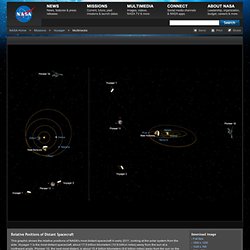
Voyager 1 is the most distant spacecraft, about 17.5 billion kilometers (10.9 billion miles) away from the sun at a northward angle. Pioneer 10, the next most distant, is about 15.4 billion kilometers (9.6 billion miles) away from the sun on the opposite side of the solar system. Voyager 2 is about 14.2 billion kilometers (8.8 billion miles) away from the sun on a southward trajectory, on the same side of the solar system as Voyager 1. Pioneer 11 is about 12.4 billion kilometers (7.8 billion miles) away from the sun. The Voyagers were built by NASA's Jet Propulsion Laboratory in Pasadena, Calif., which continues to operate both spacecraft. The sound of galactic barking dogs.
Voyager Set to Enter Interstellar Space April 28, 2011 More than 30 years after they left Earth, NASA's twin Voyager probes are now at the edge of the solar system.
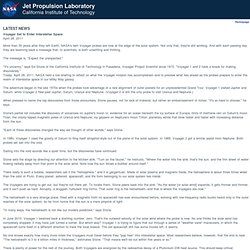
Not only that, they're still working. And with each passing day they are beaming back a message that, to scientists, is both unsettling and thrilling. Encounter with planets. 60 Frames. The cameras of Voyager 1 on Feb. 14, 1990, pointed back toward the sun and took a series of pictures of the sun and the planets, making the first ever "portrait" of our solar system as seen from the outside.
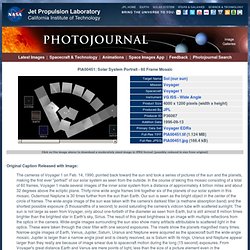
In the course of taking this mosaic consisting of a total of 60 frames, Voyager 1 made several images of the inner solar system from a distance of approximately 4 billion miles and about 32 degrees above the ecliptic plane. Thirty-nine wide angle frames link together six of the planets of our solar system in this mosaic. Earth (red photo) fades into small dot. Solar System Family Portrait Date: 14 Feb 1990 These six narrow-angle color images were made from the first ever 'portrait' of the solar system taken by Voyager 1, which was more than 4 billion miles from Earth and about 32 degrees above the ecliptic.
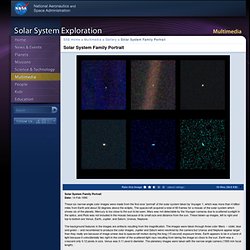
The spacecraft acquired a total of 60 frames for a mosaic of the solar system which shows six of the planets. Mercury is too close to the sun to be seen. Mars was not detectable by the Voyager cameras due to scattered sunlight in the optics, and Pluto was not included in the mosaic because of its small size and distance from the sun. These blown-up images, left to right and top to bottom are Venus, Earth, Jupiter, and Saturn, Uranus, Neptune. Triton. Global color mosaic of Triton, taken in 1989 by Voyager 2 during its flyby of the Neptune system.

Color was synthesized by combining high-resolution images taken through orange, violet, and ultraviolet filters; these images were displayed as red, green, and blue images and combined to create this color version. With a radius of 1,350 (839 mi), about 22% smaller than Earth's moon, Triton is by far the largest satellite of Neptune. It is one of only three objects in the Solar System known to have a nitrogen-dominated atmosphere (the others are Earth and Saturn's giant moon, Titan). Io Plume.
History in the making - leaving. Bow Shock. 3D Bow shock other side. Our Solar System, from the Outside This graphic, based on data from NASA's Voyager spacecraft, shows a model of what our solar system looks like to an observer outside in interstellar space, watching our solar system fly towards the observer.
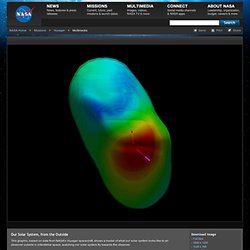
IBEX map of the heliosphere. Mapping the Heliosphere. Mapping the Heliosphere Data from NASA's Cassini spacecraft have enabled scientists to create this map of the heliosphere, the bubble of charged particles around our sun.
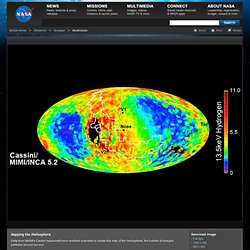
Charged particles stream out from our sun in a phenomenon known as solar wind. The solar wind interacts with the matter between stars, which is known as the interstellar medium. The mingling of interstellar medium and solar wind creates particles called energetic neutral atoms, which stream back towards the sun. The ion and neutral camera on Cassini's magnetospheric imaging instrument detects energetic neutral atoms.
Cassini detects a different spectrum of energetic neutral atoms than NASA's Interstellar Boundary Explorer (IBEX) does. The solar system's motion thru space by The Resonance Project / Nassim Haramein.avi 392351main_LindsayVis1HeliosphereMovie512x288. 392352main_LindsayVis1HeliosphereMovieHighRes. Radiation from leaving disk into galaxies bow shock. 1n 1999, Astronomers focusing on a star at the center of the Milky Way, measured precisely how long it takes the sun to complete one orbit (a galactic year) of our home galaxy: 226 million years.
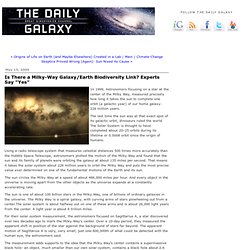
A Genocidal Orbit? -The Solar System's Journey Through the Milky Way. Is there a genocidal countdown built into the motion of our solar system?

Recent work at Cardiff University suggests that our system's orbit through the Milky Way encounters regular speedbumps - and by "speedbumps" we mean "potentially extinction-causing asteroids". Professor William Napier and Dr Janaki Wickramasinghe have completed computer simulations of the motion of the Sun in our outer spiral-arm location in the Milky Way (image left of spiral arms). These models reveal a regular oscillation through the central galactic plane, where the surrounding dust clouds are the densest. The solar system is a non-trivial object, so its gravitational effects set off a far-reaching planetoid-pinball machine which often ends with comets hurled into the intruding system. The sun is about 26,000 light-years from the center of the Milky Way Galaxy, which is about 80,000 to 120,000 light-years across (and less than 7,000 light-years thick).
Almost exactly two cycles ago, in fact. Source Links: IBEX NASA Science Update Visuals. IBEX NASA Science Update Visuals IBEX media kit:> Press Release> Feature story> Presenters biographies and photos Presenters Multimedia: Presenter 1: Eric Christian, Program Scientist (Biography)

Bow shock modeled using forces on water in sink. Voyager - The Interstellar Mission. Spacecraft Overview. The identical Voyager spacecraft are three-axis stabilized systems that use celestial or gyro referenced attitude control to maintain pointing of the high-gain antennas toward Earth. The prime mission science payload consisted of 10 instruments (11 investigations including radio science).
Only five investigator teams are still supported, though data are collected for two additional instruments. Instruments. Voyager Golden Record. Music From Earth. Scenes From Earth. Sounds from earth. Greetings. Golden Record. Pioneers 10 and 11, which preceded Voyager, both carried small metal plaques identifying their time and place of origin for the benefit of any other spacefarers that might find them in the distant future.
With this example before them, NASA placed a more ambitious message aboard Voyager 1 and 2-a kind of time capsule, intended to communicate a story of our world to extraterrestrials. The Voyager message is carried by a phonograph record-a 12-inch gold-plated copper disk containing sounds and images selected to portray the diversity of life and culture on Earth. The contents of the record were selected for NASA by a committee chaired by Carl Sagan of Cornell University, et. al. Dr. Sagan and his associates assembled 115 images and a variety of natural sounds, such as those made by surf, wind and thunder, birds, whales, and other animals. Golden Record Cover. "In the upper left-hand corner is an easily recognized drawing of the phonograph record and the stylus carried with it. The stylus is in the correct position to play the record from the beginning. Golden record diagram. Voyager's Special Cargo - The Golden Record. Voyager's Special Cargo - The Golden Record This image highlights the special cargo onboard NASA's Voyager spacecraft: the Golden Record.
Each of the two Voyager spacecraft launched in 1977 carry a 12-inch gold-plated phonograph record with images and sounds from Earth. An artist's rendering of the Voyager spacecraft is shown at bottom right, with a yellow circle denoting the location of the Golden Record. The cover of the Golden Record, shown on upper right, carries directions explaining how to play the record, a diagram showing the location of our sun and the two lowest states of the hydrogen atom as a fundamental clock reference.